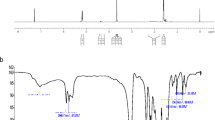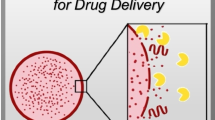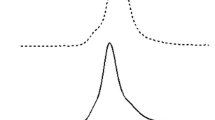Abstract
Nanoparticles based on an amphiphilic copolymer with polylactic acid (PLA) grafted onto hyperbranched polyglycerol (HPG) were prepared by the use of BSA as a model protein. The characteristics of the nanoparticles were evaluated using particle size analyzer, transmission electron microscopy, and X-ray photoelectron spectroscopy. The secondary structure of BSA released from nanoparticles were analysed by circular dichroism experiments. Cell viability of nanoparticles was also evaluated by using NIH 3T3 cells. The mechanism of BSA release was studied by fitting experimental data to three model equations. Results indicated that BSA diffusion and the polymeric relaxation jointly governed the overall release process. The detailed analysis of BSA release was performed using the first-order kinetic model equation, which gave a good fit to the experimental release data. The influence of different copolymer structures and BSA loading capacities on release profiles were also evaluated for the potential of using nanoparticles as controlled release protein delivery systems.









Similar content being viewed by others
References
Qiu LY, Bae YH (2006) Polymer architecture and drug delivery. Pharm Res 23:1–30
Ankola DD, Ravi Kumar MNV, Chiellini F, Solaro R (2009) Multiblock copolymers of lactic acid and ethylene glycol containing periodic side-chain carboxyl groups: synthesis, characterization, and nanoparticle preparation. Macromolecules 42:7388–7395
Rieger J, Freichels H, Imberty A, Putaux JL, Delair T, Jérôme C, Velty RA (2009) Polyester nanoparticles presenting mannose residues: toward the development of new vaccine delivery systems combining biodegradability and targeting properties. Biomacromolecules 10:651–657
Jiang L, Liu B, Zhang J (2009) Properties of poly(lactic acid)/poly(butylene adipate-co-terephthalate)/nanoparticle ternary composites. Ind Eng Chem Res 48:7594–7602
Gou ML, Zheng XL, Men K, Zhang J, Zheng L, Wang XH, Luo F, Zhao YL, Zhao X, Wei YQ, Qian ZY (2009) Poly(ε-caprolactone)/poly(ethylene glycol)/poly(ε-caprolactone) nanoparticles: preparation, characterization, and application in doxorubicin delivery. J Phys Chem B 113:12928–12933
Kainthan RK, Janzen J, Levin E, Devine DV, Brooks DE (2006) Biocompatibility testing of branched and linear polyglycidol. Biomacromolecules 7:703–709
Sunder A, Hanselmann R, Frey H, Mülhaupt R (1999) Controlled synthesis of hyperbranched polyglycerols by ring-opening multibranching polymerization. Macromolecules 32:4240–4246
Adeli M, Haag R (2006) Multiarm star nanocarriers containing a poly(ethylene imine) core and polylactide arms. J Polym Sci Pol Chem 44:5740–5749
Gottschalk C, Wolf F, Frey H (2007) Multi-Arm star poly (l-lactide) with hyperbranched polyglycerol core. Macromol Chem Phys 208:1657–1665
Gao H, Yang YW, Fan YG, Ma JB (2006) Conjugates of poly(dl-lactic acid) with ethylenediamino or diethylenetriamino bridged bis(β-cyclodextrin)s and their nanoparticles as protein delivery systems. J Control Release 112:301–311
Herrmann S, Winter G, Mohl S, Siepmann F, Siepmann J (2007) Mechanisms controlling protein release from lipidic implants: Effects of PEG addition. J Control Release 11:161–168
Juliana FP, de Moura Márcia R, Adley FR, Edvani CM (2008) Kinetic Study of bovine serum albumin (BSA) released from alginate-Ca2+/PNIPAAm hydrogels. Macromol Symp 266:108–113
Herrmann S, Mohl S, Siepmann F, Siepmann J, Winter G (2007) New insight into the role of polyethylene glycol acting as protein release modifier in lipidic implants. Pharm Res 24:1527–1537
Arifin DY, Lee LY, Wang CH (2006) Mathematical modeling and simulation of drug release from microspheres: implications to drug delivery systems. Adv Drug Delivery Rev 58:1274–1325
Lin CC, Metters AT (2006) Hydrogels in controlled release formulations: network design and mathematical modeling. Adv Drug Delivery Rev 58:1379–1408
Matsumoto J, Nakada Y, Sakurai K, Nakamura T, Takahashi Y (1999) Preparation of nanoparticles consisted of poly(l-lactide)–poly(ethylene glycol)–poly(Ll-lactide) and their evaluation in vitro. Int J Pharm 185:93–101
Gao X, Zhang X, Wu Z, Zhang X, Wang Z, Li C (2009) Synthesis and physicochemical characterization of a novel amphiphilic polylactic acid-hyperbranched polyglycerol conjugate for protein delivery. J Control Release 140:141–147
Barichello JM, Morishita M, Takayama K, Nagai T (1999) Encapsulation of hydrophilic and lipophilic drugs in PLGA nanoparticles by the nanoprecipitation method. Drug Dev Ind Pharm 25:471–476
Zhang X, Zhang H, Wu Z, Wang Z, Niu H, Li C (2008) Nasal absorption enhancement of insulin using PEG-grafted chitosan nanoparticles. Eur J Pharm Biopharm 68:526–534
Boyer C, Whittaker MR, Chuah K, Liu J, Davis TP (2009) Modulation of the surface charge on polymer-stabilized gold nanoparticles by the application of an external stimulus. Langmuir 26(4):2721–2730
Bradford MM (1976) A rapid and sensitive method for the quantitation of microgram quantities of protein utilizing the principle of protein-dye binding. Anal Biochem 72:248–254
Richard WK, Robert G, Eric D, Pierre B, Nikolaos AP (1983) Mechanisms of solute release from porous hydrophilic polymers. Int J Phytorem 15:25–35
Serra L, Doménech J, Peppas NA (2006) Drug transport mechanisms and release kinetics from molecularly designed poly(acrylic acid-g-ethylene glycol) hydrogels. Biomaterials 27:5440–5451
Siepmann J, Peppas NA (2001) Modeling of drug release from delivery systems based on hydroxypropyl methylcellulose (HPMC). Adv Drug Deliver Rev 48:139–157
Pitarresi G, Craparo EF, Palumbo FS, Carlisi B, Giammona G (2007) Composite nanoparticles based on hyaluronic acid chemically cross-linked with α,β-polyaspartylhydrazide. Biomacromolecules 8:1890–1898
Lewis JL, Dennis A, James C, Nora C (1985) The in vitro development of extended-release solid oral dosage forms. J Pharmacokinet Biopharm 13:493–514
Sainsbury EJ, Ashley JJ (1986) Curve-fitting in pharmacokinetics—a comparison between gamma and biexponential fits. Eur J Clin Pharmacol 30:243–244
Hiroshi S, Koichi O, Akihiro T, Nobuya H, Shigeo O, Sachio K, Robert VM (2009) Biexponential apparent diffusion coefficients in prostate cancer. Magn Reson Imaging 27:355–359
Costa P, Lobo JMS (2001) Modeling and comparison of dissolution profiles. Eur J Pharm Sci 13:123–133
Biot C, Bauer H, Schirmer RH, Charvet ED (2004) 5-Substituted tetrazoles as bioisosteres of carboxylic acids. Bioisosterism and mechanistic studies on glutathione reductase inhibitors as antimalarials. J Med Chem 47:5972–5983
Nicolaou KC, Snyder SA, Huang X, Simonsen KB, Koumbis AE, Bigot A (2004) Studies toward diazonamide A: initial synthetic forays directed toward the originally proposed structure. J Am Chem Soc 126:10162–10173
Kakuchi T, Narumi A, Matsuda T, Miura Y, Sugimoto N, Satoh T, Kaga H (2003) Glycoconjugated polymer. 5. Synthesis and characterization of a seven-arm star polystyrene with a β-cyclodextrin core based on tempomediated living radical polymerization. Macromolecules 36:3914–3920
Liu Y, Song Y, Wang H, Zhang HY, Wada T, Inoue Y (2003) Selective binding of steroids by bridged bis(β-cyclodextrin) with 2,2-biquinoline-4,4′-dicarboxylate: fluorescence enhancement induced by guest inclusion. J Org Chem 68:3687–3690
Jin X, Zhang X, Wu Z, Teng D, Wang Z, Li C (2009) Amphiphilic random glycopolymer based on phenylboronic acid: synthesis, characterization, and potential as glucose-sensitive matrix. Biomacromolecules 10:1337–1345
Peng H, Xiao Y, Mao X, Chen L, Crawford R, Whittaker AK (2009) Amphiphilic triblock copolymers of methoxy-poly(ethylene glycol)-b-poly(l-lactide)-b-poly(l-lysine) for enhancement of osteoblast attachment and growth. Biomacromolecules 10:95–104
Zeng JB, Li YD, Li WD, Yang KK, Wang XL, Wang YZ (2009) Synthesis and properties of poly(ester urethane)s consisting of poly(l-lactic acid) and poly(ethylene succinate) segments. Ind Eng Chem Res 48:1706–1711
Agarwal M, Koelling KW, Chalmers JJ (1998) Characterization of the degradation of polylactic acid polymer in a solid substrate environment. Biotechnol Prog 14:517–526
Gao H, Wang YN, Fan YG, Ma JB (2005) Synthesis of a biodegradable tadpole-shaped polymer via the coupling reaction of polylactide onto mono(6-(2 aminoethyl)amino-6-deoxy)-h-cyclodextrin and its properties as the new carrier of protein delivery system. J Control Release 107:158–173
Crotts G, Sah H, Park TG (1997) Adsorption determines in vitro protein release rate from biodegradable microspheres: quantitative analysis of surface area during degradation. J Control Release 47:101–111
Anon (2000) United States Pharmacopeia. In: Biological reactivity tests in vitro, 24th revision. United States Pharmacopeial Convention, Inc., Rockville, Maryland, pp 1813–1831
Molina I, Li S, Martinez MB, Vert M (2001) Protein release from physically crosslinked hydrogels of the PLA/PEO/PLA triblock copolymer-type. Biomaterials 22:363–369
Eijsink VG, Gåseidnes S, Borchert TV, van den BB (2006) Directed evolution of enzyme stability, Biomol Eng 22:21–30
Sriamornsak P, Thirawong N, Korkerd K (2007) Swelling, erosion and release behavior of alginate-based matrix tablets. Eur J Pharm Biopharm 66:435–450
Stulzer HK, Lacerda L, Tagliari MP, Silva MAS, Fávere VT, Laranjeira MCM (2008) Synthesis and characterization of cross-linked malonylchitosan microspheres for controlled release of acyclovir. Carbohydr Polym 73:490–497
Munday DL, Cox PJ (2000) Compressed xanthan and karaya gum matrices: hydration, erosion and drug release mechanisms. Int J Pharm 203:179–192
Zhou W, Feijen J (2008) Biodegradable polymersomes for controlled drug release. J Control Release 132:e35–e36
Ubrich N, Bouillot P, Pellerin C, Hoffman M, Maincent P (2004) Preparation and characterization of propranolol hydrochloride nanoparticles: a comparative study. J Control Release 97:291–300
Acknowledgments
This work was supported in part by the National Natural Science Foundation of China (Grant No. 20804021), the Natural Science Foundation of Tianjin (Grant No. 08JCYBJC00300) and the Ph.D. Programs foundation for new teachers of Ministry of Education of China (No. 200800551030).
Author information
Authors and Affiliations
Corresponding authors
Rights and permissions
About this article
Cite this article
Gao, X., Zhang, X., Zhang, X. et al. Encapsulation of BSA in polylactic acid–hyperbranched polyglycerol conjugate nanoparticles: preparation, characterization, and release kinetics. Polym. Bull. 65, 787–805 (2010). https://doi.org/10.1007/s00289-010-0273-2
Received:
Revised:
Accepted:
Published:
Issue Date:
DOI: https://doi.org/10.1007/s00289-010-0273-2




